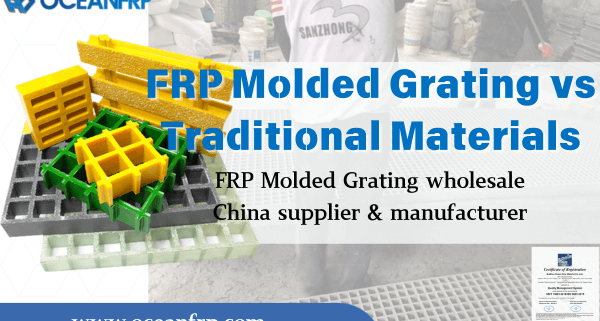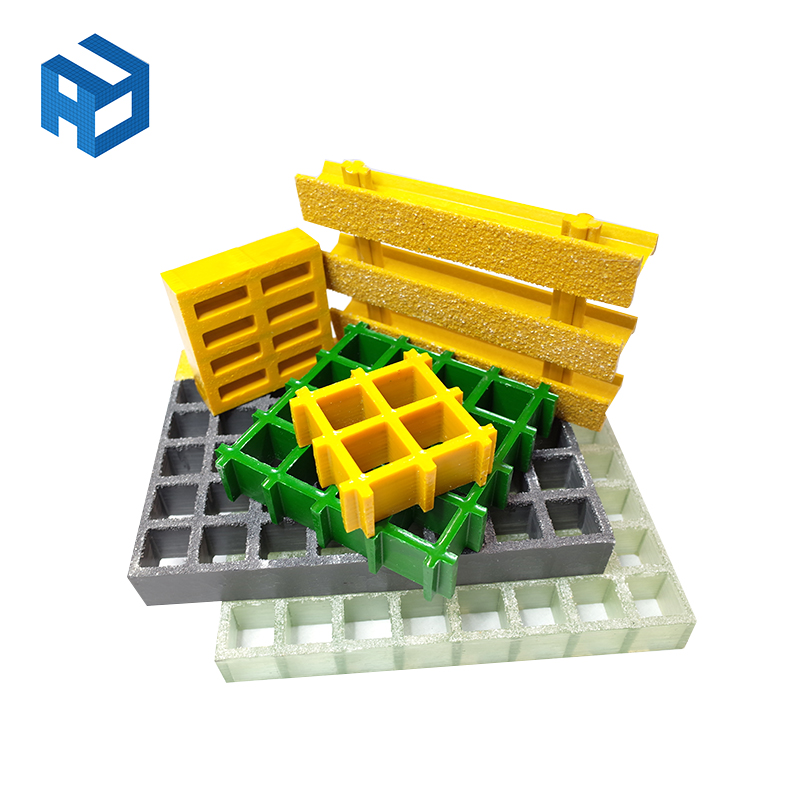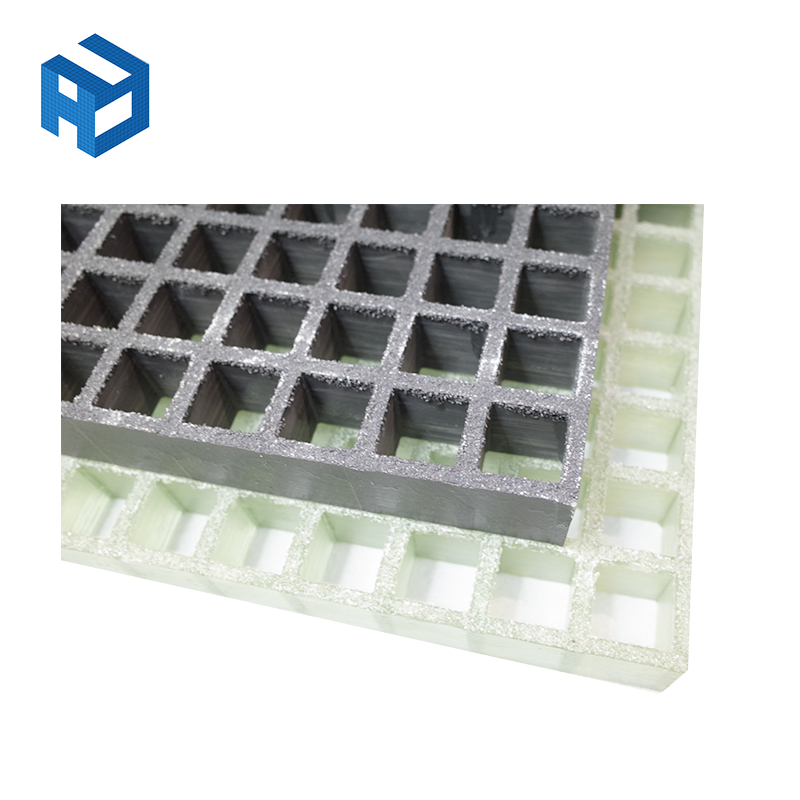FRP Molded Grating vs Traditional Materials
FRP molded grating is emerging as a premier choice for many industries, outperforming traditional materials like metal and wood in various applications. Known for its strength-to-weight ratio, it serves as an excellent option for trench covers and stair treads, providing essential slip resistance. Its durability and extended service life make it a cost-effective and reliable material for infrastructure and industrial use.
Traditional materials, while familiar, often fall short in harsh conditions where FRP-molded grating excels. Metals may corrode, wood can rot, and both lack the inherent corrosion resistance and longevity of FRP.
By offering non-sparking properties and superior slip resistance, FRP-molded grating ensures a safer working environment, especially critical in industries like mining and oil production. Let’s learn more about why you should choose FRP-molded grating over traditional materials.
What Is FRP Molded Grating?
Fiber Reinforced Plastic (FRP)-molded grating is a composite material designed for demanding applications in harsh environments, including chemical plants and areas exposed to corrosive substances. Its lightweight and high strength-to-weight ratio contribute to its growing popularity in various sectors.
FRP molded grating, a fire retardant platform, offers exceptional service life and slip resistance, making it ideal for stair treads and other safety-critical applications.
In the United States and around the world, both molded and pultruded grating options are utilized, with pultruded FRP grating providing even greater strength and stiffness for certain scenarios.
These gratings are crafted to withstand extreme conditions, resist corrosion, and maintain a flame spread rating of 25 or less. Unlike traditional metals used in mining and production, FRP gratings offer a revolutionary approach to industrial flooring and work surfaces.
Features of FRP Molded Grating
FRP molded grating offers unparalleled benefits in harsh environments, including being fire retardant with a flame spread rating of 25, corrosion resistant, and capable of enduring demanding applications. Its light weight significantly eases installation and handling, while its compatibility with chemical plants underscores its suitability for challenging industrial processes.
The diversity of FRP, with options for molded and pultruded grating, further extends its applicability across different industries. The following are the main features of FRP-molded grating:
Lightweight
The composite construction of glass fiber and resin contributes to the light weight of FRP molded grating, making it a preferred choice for easy handling and installation without compromising on strength and durability.
UV Resistant
FRP molded grating is designed to perform reliably in outdoor settings, resisting UV degradation even in wet or oily environments, which helps maintain its structural integrity and appearance over time.
Corrosion Resistant
Each grating panel is engineered to resist a wide range of corrosive elements, improving the FRP profile and making FRP molded grating an ideal choice for use in environments where traditional materials deteriorate quickly.
Fire Resistant
With intrinsic fire resistance properties, FRP molded grating provides a safer flooring option, particularly in wet or oily conditions where the risk of fire might be heightened.
Long Lasting
Designed to endure, FRP molded grating offers an extensive service life, resisting wear and tear from heavy traffic and environmental factors.
Non-Sparking
The non-sparking nature of FRP molded grating makes it a safe option for use in potentially explosive environments, adding an extra layer of protection for workers and facilities.
Cost-Efficient
FRP molded grating is a cost-efficient solution because it is long-lasting, reducing the need for frequent replacements and maintenance.
Applications of FRP Molded Grating
Due to its fire retardant properties, slip resistance, and resistance to corrosive chemicals, FRP molded grating is well-suited for demanding applications, especially in chemical plants and environments where both molded and pultruded gratings are required.
Chemical Plant and Metal Finishing
In chemical plants and metal finishing industries, FRP molded grating withstands harsh chemicals and provides a stable, corrosion-resistant work surface, which is essential for maintaining safety and operational efficiency.
Construction Engineering, Traffic, and Transportation
FRP molded grating’s durability and slip resistance make it an excellent material for construction engineering, traffic, and transportation applications, where it can be used in pedestrian walkways and platforms and as protective overlays for aging infrastructure.
Ocean Survey and Water Engineering
The corrosion-resistant nature of FRP molded grating renders it ideal for ocean survey and water engineering projects, where it stands up to salty sea spray and harsh weather conditions, preserving its structural integrity.
Food Plant
In food plants, the non-toxic and easy-to-clean surface of FRP molded grating ensures hygiene standards are met, while its resistance to various cleaning chemicals and food acids adds to its suitability for such environments.
Printing and Electronic Industry
In the printing and electronic industry, FRP molded grating steps in as a reliable alternative to traditional materials, offering trench covers with excellent slip resistance. The surface veil of these gratings ensures durability in an environment where precision and cleanliness are paramount.
Furthermore, the desired thickness and structural strength needed for the sensitive equipment can be achieved as the grating is created with layers of liquid resin and continuous fiberglass rovings through a meticulous curing process.
FRP Molded Grating vs Traditional Materials
When compared to traditional materials, the advantages of FRP molded grating become evident in commercial and industrial settings. With its resistance to corrosion, UV resistance, and insulating properties, FRP is stronger and better suited for applications requiring long-term durability.
Unlike traditional metal grating options, which are susceptible to corrosion, FRP offers structural integrity in environments like wastewater treatment and mass transit, where exposure to corrosive substances is frequent. The following is a comparison of FRP molded grating with the most commonly used traditional materials:
FRP vs Carbon Fiber
Molded FRP grating and carbon fiber materials each have their own unique benefits, but for certain applications, FRP stands out. The bearing bars and bi-directional strength of molded FRP ensure superior load capacity. Each grating panel, often with a rectangular mesh, is designed with quartz grit to provide a slip-resistant surface for added safety, making the grating surface ideal for various industrial uses.
-
Strength
FRP’s superior strength is evidenced by its glass fibers, which are integral to heavy-duty applications where pultruded gratings are utilized. These gratings are engineered for high load-bearing capacities and are often preferred over traditional materials when strength is a critical factor.
-
Safety
The fire resistance of FRP molded grating is a paramount safety feature that sets it apart from traditional materials. This characteristic makes FRP an ideal choice in industries where fire hazards are a concern, contributing to a safer working environment.
-
Durability
Thanks to its glass fibers, FRP molded grating boasts superior strength, which contributes to its durability. Designed to withstand the rigors of heavy-duty applications, pultruded gratings offer a lifespan that traditional materials often cannot match.
-
Cost
While upfront costs for FRP grating may be higher than those of some traditional materials, the long-term savings due to its durability and low maintenance often result in a lower total cost of ownership.
FRP vs Aluminum
FRP and aluminum are both popular in industries requiring lightweight materials; however, FRP offers superior strength and is not highly conductive like aluminum, making it a safer choice in electrically hazardous environments.
-
Strength
FRP’s superior strength-to-weight ratio outperforms aluminum in many structural applications, providing the necessary support without the added weight.
-
Safety
Unlike aluminum, FRP’s non-conductive nature enhances safety in electrical applications, reducing the risk of electric shock.
-
Durability
Aluminum, while resistant to corrosion, can still suffer from it under certain conditions, whereas FRP’s corrosion resistance ensures a longer lifespan in harsh environments.
-
Cost
Although the initial investment in FRP can be higher than that in aluminum, its longevity, and minimal maintenance requirements often result in lower long-term costs.
FRP vs Steel
Steel has long been used for its strength and load-bearing capabilities, but FRP molded grating challenges steel’s dominance with its corrosion-resistant and lightweight properties, making it a strong contender in many industries.
-
Strength
While steel is known for its tensile strength, FRP offers comparable structural strength with the added benefit of resistance to a wide range of corrosive chemicals, reducing the likelihood of structural failure over time.
-
Safety
FRP’s non-sparking characteristic is crucial in environments where fire risk is a concern. It provides a safer alternative to steel, especially in volatile industrial settings.
-
Durability
When comparing the durability of molded FRP grating to acrylic, FRP stands out for its robustness. The bi-directional strength of FRP, resulting from its bearing bars, contributes to a high load capacity that outperforms acrylic, especially in demanding industrial environments. Furthermore, the structure of the grating panel, often featuring rectangular mesh, endows FRP with an enduring life span, reducing the need for frequent replacements.
-
Cost
Cost efficiency is a key advantage of molded FRP grating over acrylic. While the initial investment in FRP might be higher, its longevity and minimal maintenance requirements lead to lower lifetime costs. Acrylic, on the other hand, may incur additional expenses due to its susceptibility to damage and the consequent need for more frequent replacements or repairs.
FRP vs Acrylic
Molded FRP grating offers significant advantages over acrylic in various applications. The quartz grit incorporated into the grating surface provides a slip-resistant surface for added safety, which is crucial in wet or oily conditions where acrylic may falter. Additionally, the resin systems in FRP ensure it withstands harsh chemicals and extreme temperatures, areas where acrylic might degrade.
-
Strength
FRP molded grating showcases superior strength compared to wood, especially in industrial applications. Its manufacturing techniques result in a product that resists impact and maintains structural integrity under heavy loads. Wood, while strong in certain directions, lacks the ideal solution for multidirectional load-bearing that FRP provides, making FRP a preferred choice for heavy-duty use.
-
Safety
Safety considerations favor FRP-molded grating over wood in many scenarios. FRP is non-conductive and non-sparking, reducing the risk of electrical and fire hazards in workplaces. Its slip-resistant surface also contributes to a safer environment, whereas wood can become slippery when wet and does not offer the same level of protection against accidents.
-
Durability
The durability of FRP-molded grating surpasses that of wood, particularly in corrosive environments. Wood is susceptible to rot, decay, and insect damage, which can compromise its structural integrity over time. FRP, impervious to rust and corrosion, offers long-lasting performance with minimal maintenance costs, even in harsh conditions.
-
Cost
Regarding cost, FRP-molded grating presents a competitive edge over wood. Although the upfront cost may be higher, the long-term maintenance costs for FRP are significantly lower. Wood, while initially more affordable, often incurs higher expenses in maintenance, treatments, and replacements, especially in harsh industrial settings.
FRP vs Wood
In a comparison between FRP-molded grating and wood, the former often emerges as the more durable and cost-effective option for industrial applications. Resin systems used in FRP provide resistance to environmental factors that can deteriorate wood, reducing maintenance requirements. Particularly in regions like Latin America, with diverse climates FRP’s resilience makes it an ideal solution for long-term infrastructure projects.
Wrap-Up!
In conclusion, FRP molded grating presents a multitude of advantages over traditional building materials, making it a superior choice for many applications. Its unique properties, such as being lightweight, corrosion-resistant, and fire-resistant, offer significant benefits, particularly in harsh environments like the oil and gas industry. These features not only extend the lifespan of installations but also contribute to safety and cost-efficiency in the long term.
Enduro composites are at the forefront of this innovation, providing durable and reliable FRP solutions that meet the demands of various industries. By choosing FRP molded grating, businesses can enjoy a high-performing option that withstands the test of time and elements, ultimately leading to a smarter, more sustainable infrastructure.





